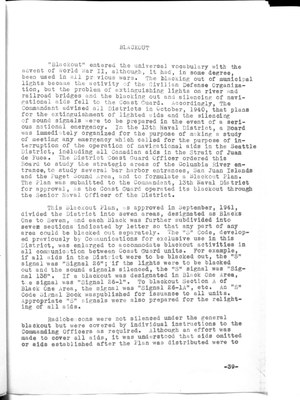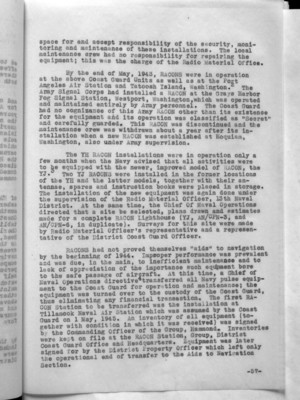Pages That Mention Commanding Officer
Coast Guard District narrative histories 1945
59
"Blackout" entered the universal vocabulary with the advent of World War II, although, it had, in some degree, been used in all previous wars. The blacking out of municipal lights became the activity of the Civilian Defense Organization, but the problem of extinguishing lights on river and railroad bridges and the blacking out and silencing of navigational aids fell to the Coast Guard. Accordingly, The Commandant advised all Districts in October, 1940, that plans for the extinguishment of lighted aids and the silencing of sound signals were to be prepared in the event of a serious national emergency. In the 13th Naval District, a Board was immediately organized for the purpose of making a study of meeting any emergency which called for the purpose of interruption of the operation of navigational aids in the Seattle District, including all Canadian aids in the Strait of Juan de Fuca. The District Coast Guard Officer ordered this Board to study the Strategic areas of the Columbia River entrance, to study several bar harbor entrances, San Juan Islands and the Puget Sound Area, and to formulate a Blackout Plan. The Plan was submitted to the Commandant, 13th Naval District for approval, as the Coast Guard operated its blackout through the Senior Naval Officer of the District.
This Blackout Plan, as approved in September, 1941, divided the District into seven areas, designated as Blacks One to Seven, and each Black was further subdivided into seven sections indicated by letter so that any part of any area could be blacked out separately. The "S" Code, developed previously by Communications for exclusive use in this District, was enlarged to accommodate blackout activities in all communication between Coast Guard units. For example, if all aids in the District were to be blacked out, the "S" signal was "Signal 26"; if the lights were to be blacked out and the sound signals silenced, the "S" signal was "Signal 138". If a blackout was designated in Black One Area, the signal was "Signal 26-1A", etc. An "S" Code Signal Book was published for issuance to all units. Appropriate "S" signals were also prepared for the relighting of all aids.
Radiobeacons were not silenced under the general blackout but were covered by individual instructions to the Commanding Officers as required. Although an effort was made to cover all aids, it was understood that aids omitted or aids established after the Plan was distributed were to
-39-
77
space for and accept responsibility of the security, monitoring and maintenance of these installations. The local maintenance crew had no responsibility for repairing the equipment; this was the charge of the Radio Material Office.
By the end of May, 1943, RACONS were in operation at the above Coast Guard Units as well as at the Port Angeles Air Station and Tatoosh Island, Washington. The Army Signal Corps had installed a RACON at the Grays Harbor Fog Signal Station, Westport, Washington, which was operated and maintained entirely by Army personnel. The Coast Guard had no cognizance of this Army RACON other than its existence for the equipment and its operation was classified as "Secret" and carefully guarded. This RACON was discontinued and the maintenance crew was withdrawn about a year after its installation when a new RACON was established at Hoquiam, Washington, also under Army supervision.
The YH RACON installations were in operation only a few months when the Navy advised that all activities were to be equipped with the newer, improved model of RACON, the YJ.³ Two YJ RACONS were installed in the former locations of the YH and the latter models, together with their antennae, spares and instruction books were placed in storage. The installation of the new equipment was again done under the supervision of the Radio Material Officer, 13th Naval District. At the same time, the Chief Of Naval Operations directed that a site be selected, plans drawn and estimates made for a complete RACON Lighthouse (YJ, AN/CPN-3, and AN/CPN-6, in duplicate). Surveys for this site were made by Radio Material Officer's representative and a representative of the District Coast Guard Officer.
RACONS had not proved themselves "aids" to navigation by the beginning of 1944. Improper performance was prevalent and was due, in the main, to inefficient maintenance and to lack of appreciation of the importance such equipment bore to the safe passage of aircraft. At this time, a Chief of Naval Operations directive^4 transferred all Navy pulse equipment to the Coast Guard for operation and maintenance; the equipment was turned over to the custody of the Coast Guard, thus eliminating any financial transaction. The first RACON Station to be transferred was the installation at Tillamook Naval Air Station which was assumed by the Coast Guard on 1 May, 1945. An inventory of all equipment (together with condition in which it was received) was signed by the Commanding Officer of the Group, Hammond. Inventories were kept on file at the RACON Station, Group, District Coast Guard Office and Headquarters. Equipment was later signed for by the District Property Officer which left only the operational end of transfer to the Aids to Navigation Section.
-57-
79
(f) Arrange for the establishment of an appropriate system whereby all users of RADAR beacons are promptly notified of outages or defects.
(g) Prepare and disseminate operating instructions for RADAR beacons.
(h) Obtain and analyze operational reports from users and from field activities in the interest of bettering the service rendered to navigators using RADAR beacons.
(i) Advise the Communications Officer as to communication facilities required.
An Assistant Aids to Navigation Officer, especially trained in electronic aids, was assigned to the District to work particularly in this field.
When the transfer of RACONS from Navy to Coast Guard was pending, the Commanding Officer of the Blimp Squadron 33 at Tillamook, Oregon, fearing the coastal RACONS might be discontinued, set forth the importance of the RACON to his command as follows: "The airship, a slow moving aircraft designed to operate in conditions of reduced visibility at a low altitude, has, when such weather conditions exist, become dependent upon the coastal RACON Stations located clear of all interference of land masses as a primary method of making a landfall...... It is often difficult to identify portions of the coast in the P. P. I. (position plot indicator) scope due to the similarity of the received images of the bays and capes of this coastline. The airships position is immediately and positively verified upon timing in the RACON signals". This gave evidence that the earlier stigma of "inefficient operation and improper maintenance" of the RACONS was being eliminated. In five months of operation, under the Coast Guard supervision, nine failures occurred but only one RACON lost actual operating time (2 hours 15 minutes) as the standby units were switched on in all other instances. The following table shows the usage of the 13th Naval District existing RACONS during the June, July and August months of 1945:
-59-


